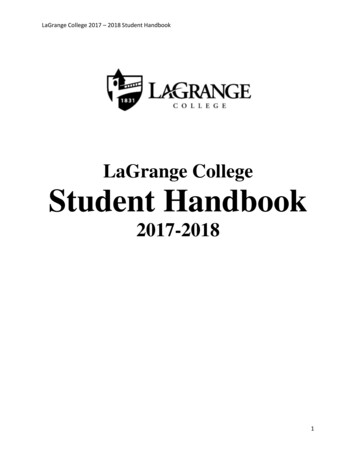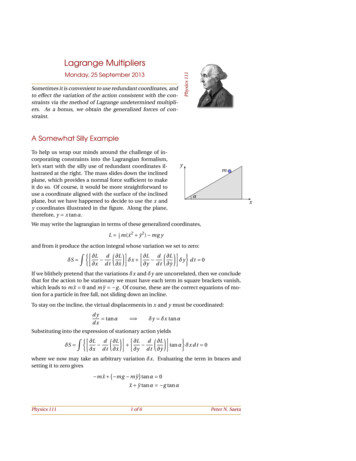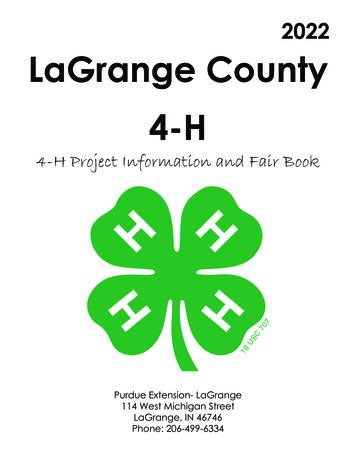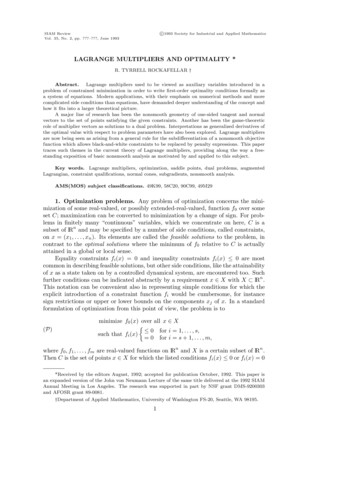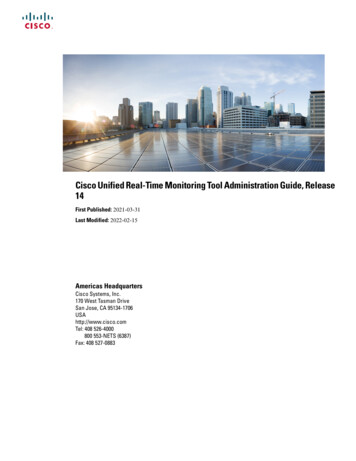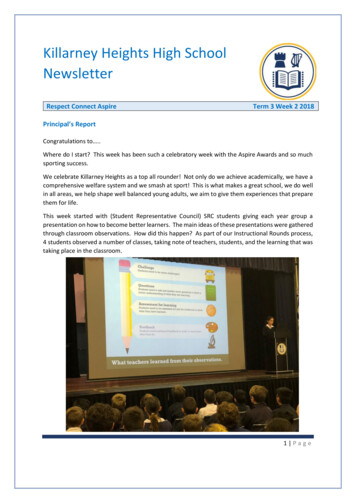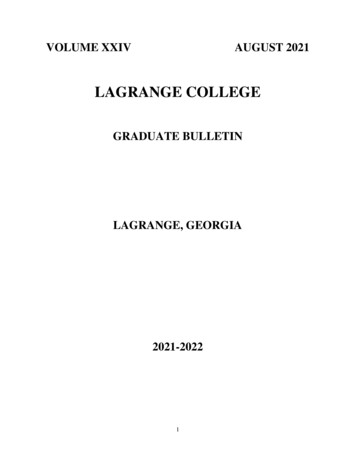
Transcription
VOLUME XXIVAUGUST 2021LAGRANGE COLLEGEGRADUATE BULLETINLAGRANGE, GEORGIA2021-20221
COMMUNICATIONS DIRECTORY4MISSION5HISTORY AND DESCRIPTION6ACCREDITATION8THE LAGRANGE COLLEGE CAMPUS9ADMISSION AND ENROLLMENT14FINANCIAL INFORMATION20FINANCIAL AID25STUDENT ENGAGEMENT33ATHLETIC PROGRAM65INFORMATION TECHNOLOGY AND ACADEMIC SUPPORT67ACADEMIC POLICIES72ACADEMIC PROGRAMS89ACADEMIC DEPARTMENTS, PROGRAMS, AND COURSES92FACULTY127BOARD OF TRUSTEES128PRESIDENT'S CABINET132ADMINISTRATIVE STAFF1332
CHANGE OF REGULATIONSThe College reserves the right to make modifications in the degree requirements, courses,schedules, calendar, regulations, fees, and other changes deemed necessary or conducive to theefficient operation of the College. Such changes become effective as announced by the properCollege authorities.BULLETIN EFFECTIVE DATE: June 1, 2021, for current (2021-2022) academic yearNote:For information, regulations, and procedures for undergraduate study, see the LaGrange CollegeBulletin.3
COMMUNICATIONS DIRECTORYLaGrange College601 Broad StreetLaGrange, Georgia 30240-2999706.880.8000http://www.lagrange.edu/For prompt attention, please address inquiries as indicated below:LaGrange College (general information)706.880.8000Office of the President706.880.8240Vice President for Academic Affairs706.880.8236Registrar706.880.8024Vice President for Student Engagement706.880.8976Director of Career Development Center706.880.8185Director of Communications and Marketing706.880.8246Director of Financial Aid706.880.8249Chief Information Officer706.880.8050Vice President for External Relations706.880.8223Vice President for Enrollment Management706.880.8253Vice President for Finance and Operations706.880.8223The administrative offices in Banks Hall are open 8:00 a.m. to 5:00 p.m. Monday through Friday.Saturday visits may be arranged by appointment. Visitors desiring interviews with members of thestaff are urged to make appointments in advance.LaGrange College admits qualified students of any race, color, nationality, and ethnic origin to allrights, privileges, programs, and activities generally accorded or made available to students at theschool. It does not discriminate on the basis of age, color, race, national or ethnic origin, disability,or sex, sexual orientation, gender identity, or gender expression in administration of its educationalpolicies, admissions policies, scholarship and loan programs, and athletic and other schooladministered programs.LAGRANGE COLLEGE GRADUATE BULLETIN, VOLUME XXIVPRESIDENT: DR. SUSANNA L. BAXTERLaGrange College Graduate Bulletin, the official publication of LaGrange College for current andfuture graduate students, is published annually.Challenging the mind. Inspiring the soul. Transforming lives.4
MISSIONLaGrange College challenges the minds and inspires the souls of its students. Founded in1831 and committed to its relationship with the United Methodist Church and its Wesleyanand liberal arts traditions, the college supports students in their search for truth. An ethicaland caring community that values excellence, service, civility, diversity and inclusion,LaGrange College prepares its students to become successful, responsible citizens who aspireto lives of integrity and moral courage.LaGrange College challenges the minds and inspires the souls of its students.Through an interdisciplinary, broad-based general education curriculum, rigorous study inthe major disciplines, innovative learning opportunities and integrative co-curricularprograms, LaGrange College students encounter experiences that challenge and inspirethem to develop intellectually, socially, and spiritually.Founded in 1831 and committed to its relationship with the United Methodist Church and itsWesleyan and liberal arts traditions, the college supports students in their search for truth. The oldest private college in the state of Georgia, the institution has been affiliated with theUnited Methodist Church for more than 150 years.Firmly rooted in the Christian faith and grounded in the Wesleyan and liberal artstraditions, both of which are devoted to the unfettered pursuit of truth, the collegeencourages students to deepen their understanding of their faith and empowers them toengage in free intellectual inquiry.Welcoming students from widely diverse backgrounds and a variety of faith traditions, thecollege fosters an environment of respect and humility and is committed to the ideals ofreligious and academic freedom.An ethical and caring community valuing civility, diversity, service and excellence, LaGrangeCollege prepares students to become successful, responsible citizens who aspire to lives ofintegrity and moral courage. Understanding the necessity of informed thought directed toward responsible decisionmaking, the academic programs of the college provide opportunities for students to grow intheir ability to communicate effectively, to encounter the world with critical insight, and toapproach problems and opportunities with creativity.Committed to the success of students as members of the college community and as alumni,the institution encourages students to see life and work as deeply related and to engagethemselves in rich opportunities for meaningful service.Aware of the global nature of 21st -century learning and living, the college providesmultiple opportunities for students to experience distant cultures and diverse peoplesthrough study-away options, language study, internships, and a wide exposure to culturalenrichment events – all in the context of academic study and action that foster responsible,sustainable stewardship.Adopted by Faculty, Administration, and Board of Trustees, 20195
HISTORY AND DESCRIPTIONThe history of LaGrange College is closely associated with the history of the City of LaGrange andTroup County. When the vast tract of land lying between the Flint and Chattahoochee Rivers wassecured by the Indian Springs Treaty of 1825 and was opened for settlement in 1827, one of thefive counties formed on the western border of the state was named Troup in honor of GovernorGeorge Michael Troup.An act was passed by the Georgia Legislature on December 24, 1827, providing for the selectionof a county seat. It was named “LaGrange” after the country estate of the Marquis de Lafayette, theAmerican Revolutionary War hero who had visited the region in 1825 as the guest of GovernorTroup. The site for the town of LaGrange was purchased in 1828, and the town was incorporatedon December 18, 1828. On December 26, 1831, the charter for the LaGrange Female Academywas granted at the state capitol, then in Milledgeville.In 1831 Andrew Jackson was president of the United States. Abraham Lincoln was 22 years old.The Creek Indians had been moved out of this area of the state only six years earlier. The onlyother college in the state was Franklin College, now the University of Georgia.In 1847 the charter for the school was amended and the school became the LaGrange FemaleInstitute with power to confer degrees. The name was changed to LaGrange Female College in1851, and in 1934 it was changed to LaGrange College. The College became officiallycoeducational in 1953.The first location of the school was in a large white building at what is now 406 Broad Street. Theschool moved to its present location on "the Hill," the highest geographical point in LaGrange,after the construction of the building now known as Smith Hall in 1842. The College was sold tothe Georgia Conference of the Methodist Episcopal Church South in 1856. Today it is aninstitution of the North Georgia Conference of the United Methodist Church.LaGrange College offers the Bachelor of Arts degree with nineteen (19) majors, the Bachelor ofScience degree in six (6) areas, the Bachelor of Music, the Bachelor of Business Administration,and the Bachelor of Science in Nursing degree. The graduate programs offered are the Master ofArts degree in Teaching, the Master of Education degree in Curriculum and Instruction, theSpecialist in Education degree in Teacher Leadership, and the Master of Arts in Clinical MentalHealth Counseling. The Evening program offers the Bachelor of Arts degree.LaGrange College operates on the modified (4-1-4) semester system. The summer session iscomposed of two (2) part-sessions and one full through-session. All credits earned are semesterhour credits.The College draws more than half of its student body from Georgia. However, students from atleast one-third of the other states in the U.S. and from abroad nourish a rich cosmopolitan andinternational community that includes various religious and ethnic backgrounds.Students also are provided diversity opportunities through travel courses, field study programs,service-learning, and internships. Students in the College's Education and Nursing departmentsreceive supervised learning experiences in many area schools and medical facilities, respectively.Campus art exhibitions, lectures, concerts, and varsity and intramural sports add to the culturalenrichment and recreational opportunities offered by the College.The College is located in the town of LaGrange, Georgia, which has a population of 26,000.Nearby are Callaway Gardens, the Warm Springs Foundation, and Franklin D. Roosevelt's LittleWhite House. The West Point Dam on the Chattahoochee River provides one of the largest lakes in6
the region, with waterfronts and a marina within the city limits of LaGrange.7
ACCREDITATIONLaGrange College is accredited by the Southern Association of Colleges and Schools Commissionon Colleges to award baccalaureate and master’s degrees as well as the educational specialistdegree. Contact the Southern Association of Colleges and Schools Commission on Colleges at1866 Southern Lane, Decatur, Georgia 30033-4097 or call 404-679-4500 for questions about theaccreditation of LaGrange College.LaGrange College is also approved by the United Methodist University Senate. It has membershipin the National Association of Independent Colleges and Universities and the Georgia IndependentCollege Association.LaGrange College’s teacher education (undergraduate and graduate) programs are accredited bythe Georgia Professional Standards Commission to recommend candidates for initial teachercertification in the areas of elementary education, music education, middle grades education, andsecondary education.The Bachelor of Science in Nursing (BSN) and the online RN to BSN programs are accredited bythe Accreditation Commission for Education in Nursing (ACEN), 3343 Peachtree Road, NE, Suite850, Atlanta, GA 30326; Marsal Stoll, EdD, Chief Executive Officer; 404-975-5000,mstoll@acenursing.orgThe undergraduate programs in Business and Accountancy are accredited by the AccreditationCouncil for Business Schools and Programs (ACBSP).The Council for Accreditation of Counseling and Related Educational Programs (CACREP), abody that been nationally recognized by the Council for Higher Education Accreditation (CHEA),has granted accreditation to the Clinical Mental Health Counseling (M.A.) program.8
THE LAGRANGE COLLEGE CAMPUSBANKS HALLOriginally built in 1963, the building served the campus as its library until the Frank and LauraLewis Library opened in February 2009. Renovated in 2009, the building now houses Admissions,Financial Aid, the Business Office, the Registrar’s Office, the Vice President for Enrollment, theVice President for Academic Affairs (VPAA), the Vice President for External Relations, the VicePresident for Finance and Operations, and the President.J. K. BOATWRIGHT HALLCompleted in 1962, this three-story brick building serves as a men’s dormitory. J. K. BoatwrightHall is named in memory of a longtime member of the College’s Board of Trustees and chairmanof the board’s executive committee from 1956-1962. New designs were incorporated inrenovations to the building in 2003.BROAD STREET APARTMENTSOriginally constructed in 1936 and fully renovated in 2012, the Broad Street Apartments, locatedtwo blocks east of the main campus, and presented to the College as a gift from the CallawayFoundation, Inc., now house the Servant Scholars Program.FULLER E. CALLAWAY ACADEMIC BUILDINGCompleted in 1981 and renovated in 2000, the Fuller E. Callaway Academic Building houses theHistory, Political Science, Sociology, and Psychology programs.CALLAWAY AUDITORIUMBuilt in 1941, Callaway Auditorium was originally designed as a multipurpose venue, and itserved ably in that capacity for well over half a century, hosting countless basketball games,volleyball matches, dances, children’s recitals, luncheons, and other varied events. Thoughversatile, the facility was severely limited in its ability to provide an accommodation that wasgreatly needed by the community and LaGrange College: an acoustically pleasing musicperformance venue.The demand for such a facility was satisfied in 2005 with the auditorium’s transformation from a“gym with a stage” to a state-of-the-art concert hall. Funded jointly by LaGrange College andCallaway Foundation, Inc., the 5.5 million renovation called for an almost complete internalmakeover and a new roof. And while the hall’s visual appearance has changed dramatically, thesingle most important improvement is the superior sound quality that the Auditorium now delivers.CALLAWAY CAMPUSAcquired by the College in 1992 as a gift from Callaway Foundation, Inc., the campus includesthree buildings of brick and concrete construction. Callaway Foundation, Inc. donated funds tobuild a state-of-the-art lighted soccer field there in 1995. The Callaway Campus also includes asoftball complex, tennis courts, swimming pools, and a football practice field.CALLAWAY EDUCATION BUILDINGBuilt in 1965, renovated in 1994, and given a 2 million, 17,000-square-foot addition in 2006, thebuilding houses the offices of Intercollegiate and Intramural athletics, offices of Health andPhysical Education, a weight room, an athletic training room, and a football locker room.9
CASON J. CALLAWAY SCIENCE BUILDINGBuilt in 1972 and renovated in 2017, this three-story brick building primarily provides forinstruction in Math and Physics. The building is named in memory of a former member of thecollege’s Board of Trustees and houses the Charter Computational Mathematics Lab.WARREN A. CANDLER COTTAGECompleted in 1929 as a home for the College president, Candler Cottage now houses offices inExternal Relations.LEE EDWARDS CANDLER AND HAWKINS RESIDENCE HALLSLee Edwards Candler and Hawkins Residence Halls were completed in 2002. Each apartment-stylehall houses 124 students. Arranged in either two- or four-bedroom floor plans with one bathroomper two students, the apartments are fully furnished and have a full kitchen. A community roomalso is located at the end of one wing in each building. Candler Hall is named in memory of Mrs.Lee Edwards Candler. Hawkins Hall is named in honor of Annie Carter Hawkins and in memoryof Allen Willard Hawkins, Sr., parents of Scott Hawkins ’74.THE CHAPELThe materials used in the construction of the Chapel in 1965 link it with Christian worship inLaGrange and other parts of the world. Included in the structure are two stained glass windowsmade in Belgium more than 100 years ago; a stone from the temple of Apollo at Corinth, Greece; astone from the Benedictine Monastery in Iona, Scotland; and a stone from St. George’s Chapel inWindsor, England. Regular worship services are held when the College is in session.CLEAVELAND FIELDCleaveland Field opened in 2000 as LaGrange College’s new 2.21 million baseball facility.Callaway Foundation, Inc. gave a challenge grant as well as the land to honor Philip Cleaveland,who served the College as a trustee for 19 years.HAWKES HALLCompleted in 1911, this four-story brick building is named in memory of Mrs. Harriet Hawkes,mother of College benefactor A.K. Hawkes. Following a 1.4 million renovation, the building nowhouses women students on its second, third, and fourth floors. Faculty offices and classrooms forthe Department of Education occupy the ground floor. Also on the second floor is the NixonParlor, named in honor of longtime College supporter Winifred Adams Nixon ‘33.WAIGHTS G. HENRY, JR., RESIDENCE HALLCompleted in 1970, this five-story brick building provides student housing. The structure is namedin honor of the late Dr. Waights G. Henry, Jr., who served as president of the College from 19481978 and as chancellor from 1978 until his death in 1989. The building also houses a 24-hourcomputer lab open to all students.CHARLES D. HUDSON NATATORIUMThe swimming pool was constructed in 1947 as an oversized pool with dimensions of 80 by 150feet. The cabana and bathhouse were built in 1956. Today, the oversized pool has been dividedinto an outdoor pool and a natatorium, and the complex is now equipped for a year-round aquaticsprogram. The Natatorium is named in honor of Dr. Charles D. Hudson, longtime chair of the10
Board of Trustees and retired chair of the Board’s Executive Committee.IDA CALLAWAY HUDSON LAB SCIENCES BUILDINGOpened in February 2017, this state-of-the-art, 40,000-square foot facility, Hudson Lab SciencesBuilding, houses laboratories for instruction in anatomy/physiology, biology, chemistry, ecology,cell and molecular biology, microbiology and organic chemistry and designated space forundergraduate research. It includes a nuclear magnetic resonance machine and an atomicabsorption spectrophotometer.LAMAR DODD ART CENTERCompleted in 1982 and fully renovated and modernized in 2011, this building provides a physicalenvironment and the equipment needed for art instruction as well as gallery space for the College’soutstanding art collection. The building is named in honor of the late Lamar Dodd, a Georgia artistwho grew up in LaGrange and whose paintings won international recognition.FRANK AND LAURA LEWIS LIBRARYThe Frank and Laura Lewis Library at LaGrange College is a 45,000 square foot facility located atthe center of campus. Built in 2009, the Library is named for Frank and Laura Lewis and is LEEDsilver certified; Frank Lewis was the first African American Director of the Library at LaGrangeCollege, while Laura Lewis was a librarian for Ethel Kight Elementary School in Troup County.The Library has over 80,000 print resources and over 500,000 electronic resources. In addition tothe print resources, the Library houses individual and group study rooms, an auditorium, a multimedia classroom, a media lounge, a computer lab, and research study carrels. The Library also hasa 24-hour study center with a coffee and snack bar.LOUISE ANDERSON MANGET BUILDINGBuilt in 1959 and completely renovated in 2001, the Louise Anderson Manget Building houses theHumanities Department, including the programs of English, Latin American Studies and ModernLanguages, and Religion and Philosophy.ALFRED MARIOTTI GYMNASIUMBuilt in 1959, the Mariotti Gymnasium houses the exercise science laboratory, physical educationclassrooms, and facilities for indoor athletics. The facility is named in memory of Coach AlfredMariotti, the College’s basketball coach from 1962 until 1974 and a member of the faculty until hisretirement in 1979.MITCHELL BUILDINGThe Mitchell Building is located on the grounds of Sunny Gables Alumni House. It was named inmemory of Evelyn Mitchell, a trustee of the Arthur Vining Davis Foundations.MARGARET ADGER PITTS DINING HALLCompleted in 1962 and renovated most recently in 2012, this two-story brick building houses thedining area and kitchen on the main floor, and the College Bookstore, post office, and printingcenter on the bottom floor. The building is dedicated in honor of the late Margaret Adger Pitts, aformer College trustee.11
PITTS RESIDENCE HALLCompleted in 1941, this two-story brick women’s dormitory was renovated in 1990. Pitts Hall wasrededicated in memory of Mr. and Mrs. W. I. H. Pitts and in honor of their daughter, the lateMargaret Adger Pitts, a former College trustee. The members of the Pitts family were longtimesupporters of the College.PRESIDENT’S HOMEAcquired by the College in 1964, this home originally was occupied by local attorney and formertrustee Hatton Lovejoy. The first College family to live in the house was that of Dr. Waights G.Henry, Jr., who moved from the former president’s residence in Candler Cottage. Designed in1934, the home represents a combination of Georgian and Neoclassical elements.PRICE THEATERCompleted in 1975 and renovated in 2013, this building features a 280-seat proscenium theaterwith 36 fly lines, 8 electrics (including 4 beam positions over the auditorium), and a hydraulicorchestra pit. It also houses the Theatre Arts program, including faculty offices, a sceneryworkshop, dressing rooms, a costume shop, an actors’ lounge, classroom, and the Lab Theatre.QUILLIAN BUILDINGBuilt in 1949 and named in memory of former president Hubert T. Quillian, who served from1938-1948, this building currently provides offices for Human Resources and the Department ofInformation Technology.SMITH HALLSmith Hall is the oldest building on the campus. The main portion of the building was constructedin 1842 of handmade brick formed from native clay. An addition was built in 1887, and a majorrenovation was completed in 1989 at a cost of over 2.5 million. The building now houses offices,classrooms, and seminar rooms. Smith Hall was named in memory of Mrs. Oreon Smith, wife offormer College president Rufus W. Smith, who served from 1885 until his death in 1915. Thebuilding is listed in the National Register of Historic Places.TURNER HALLBuilt in 1958 (not long after the institution became co-educational), this three-story brick buildingwas first used to provide campus housing for men, and later, women. In 2003, the structure wasrenovated and enlarged. The Mabry Gipson Student Center features large and small meetingrooms, a student grill, and the Jones Zone on the first two floors. Student housing on the third flooris known as the William H. Turner, Jr., Residence Hall. It is named in memory of Mr. Turner, atextile executive of LaGrange, who was a benefactor of the College, a longtime member of theBoard of Trustees, and chairman of the board’s executive committee from 1929 until 1950.SUNNY GABLES ALUMNI HOUSEBuilt by Mary and Julia Nix in 1925, Sunny Gables Alumni House is an outstanding example ofearly 20th century Tudor Revival architecture. Designed by P. Thornton Marye, it is now part ofthe National Register of Historic Places’ Vernon Road Historic District. This multipurpose facilityserves as the permanent home for alumni. The facility extends entertainment space to the College’sconstituents for specific programming purposes.12
WEST SIDEFormerly a Troup County magnet school for the arts, West Side was purchased in 2014 andextensively renovated to house the college’s Nursing, Music and Digital Creative Media (film)programs. The facility features state-of-the-art equipment for all areas, as well as a 150-seat recitalhall, live recording studio and rehearsal space for chamber choir, percussion ensemble andmarching and concert bands.13
ADMISSION AND ENROLLMENTLaGrange College welcomes applications from goal-centered students who embrace the challengeto learn and to serve others. The application and admission process at LaGrange College isselective and focuses on each applicant’s interests, goals, academic readiness for college-levelwork, and college expectations. We seek applicants who have the potential to be successfulacademically and who will contribute to our community in meaningful ways.Admission Counselors are available to advise prospective students and families about theadmission process and requirements, financial aid and scholarships, and arranging a campus visit.The Office of College Access and Admission will also provide admission and financial aidpublications and other pertinent information, as well as the appropriate application packet uponrequest.Prospective students are strongly encouraged to visit the campus and to interview with anAdmission Counselor. Campus visits and interviews may be scheduled Monday through Friday at10:00 AM or 2:00 PM during the academic year. To arrange an appointment, call the Office ofCollege Access and Admission at 800-593-2885 or 706-880-8005, e-mail the office atadmission@lagrange.edu, or visit the College’s website at www.lagrange.edu.ADMISSION AS A TRANSFER STUDENTLaGrange College welcomes applications from qualified students who wish to transfer from otherregionally accredited colleges and universities, provided that they are eligible to return to theircurrent institution at the time of entry to LaGrange College. Accepted applicants may enroll at thebeginning of any semester. Applications for admission are reviewed on a rolling basis andadmission decisions are reached upon receipt of all official documents and transcripts.Basis of SelectionFor the purpose of admission, a transfer student is defined as a student who is enrolled and is ingood standing in a graduate program at a regionally accredited college or university after havinggraduated from an undergraduate program, and who is seeking enrollment in a graduate program atLaGrange College. Applicants who do not meet this definition must meet the same admissioncriteria as all other new graduate students. In order to be eligible for regular admission toLaGrange as a transfer student, one must have earned a minimum of a 3.0 or higher GPA on allwork attempted at the graduate level.A transfer student must be in good academic standing at all previously attended institutions.Transfer applicants under academic or disciplinary suspension or dismissal from a previousinstitution cannot be admitted to LaGrange until such sanctions are lifted. Transfer applicants notmeeting the requirements listed above will be reviewed by the Faculty Admission Committee. Astudent may be provisionally admitted under the criteria for provisional admission as determinedby each program. Prior to the student’s admission to LaGrange College, the Office of CollegeAccess and Admission must receive all necessary documents, including official transcripts of allcollege coursework and any required examination scores. Any applicant who intentionallywithholds information about college coursework previously attempted, either by failing to reportthat coursework or by failing to provide an appropriate transcript, will be subject to a revocation ofadmission extended by LaGrange College.14
Transfer Application ProceduresTo apply for admission as a transfer student, a student should submit the following:1. A completed application for admission. Applications must be signed and dated by thestudent, or students must electronically sign the application if they are completing an onlineapplication;2. Official score reports of any pertinent and required examinations as specified by eachprogram.3. An official transcript from each college or university attended. If currently enrolled, asecond transcript will be required indicating completion of the semester and eligibility toreturn to the institution. To be considered an official document, a transcript should besubmitted directly to the Office of College Access and Admission at LaGrange College in asealed envelope from the sending institution. Institutional records personally delivered toLaGrange College by a student must also be in a sealed envelope in order to be consideredofficial. Photocopies, faxes, or transcripts in unsealed envelopes are not considered official.Enrollment Verification Procedures—TransfersAn admitted graduate transfer student must notify the program coordinator and the Office ofAdmission of their intent to enroll by the priority notification deadline as specified by eachgraduate program.During the orientation session(s) hosted by each graduate program, each student will meet with anacademic advisor to discuss the program requirements, the curriculum, and course selections forthe semester. If all official final college and university transcripts have not been received andevaluated by the College, a transfer student’s first semester of enrollment may be affected.Before classes begin, transfer students must finalize their financial arrangements with the Office ofFinancial Aid and Affordability in regard to tuition and other fees.Admission of International Graduate StudentsLaGrange College is pleased to receive and review applications for admission from internationalstudents. Increasing international understanding is valued at LaGrange College. In promoting thatunderstanding, LaGrange College seeks to enroll an internationally diverse student body. TheCollege serves as a host or home base institution for short-term international visitors and hasexecuted a cooperative agreement Instituto Laurens in Monterrey, Mexico. Since correspondencefor international admission can be extensive and time consuming, it is strongly recommended thatstudents apply by May 15th for the Fall Semester, and by October 15th for the Spring Semester.Basis of SelectionLaGrange College is authorized under the United States Citizenship and Immigration Services(USCIS) to enroll non-immigrant alien students. Admission to LaGrange College requiressubmission of the international student application, application fee, and translated and certifieddocuments attesting to the student's academic performance in university studies. These students arerequired to follow the prescribed admission procedures below and to take either the Test of Englishas a Foreign Language examination (TOEFL), the GRE (as required), and to provide an officialstatement of financial resources sufficient to support educational costs. Students should consult thespecific graduate programs for additional admission requirements.15
Academic PreparationAn international graduate applicant must meet all clear and unconditional admission requirementsas specified by each graduate program. International graduate applicants c
Specialist in Education degree in Teacher Leadership, and the Master of Arts in Clinical Mental Health Counseling. The Evening program offers the Bachelor of Arts degree. LaGrange College operates on the modified (4-1-4) semester system. The summer session is composed of two (2) part-sessions and one full through-session.
